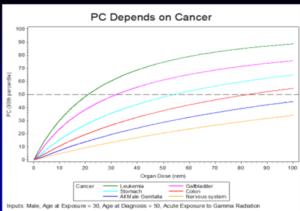
CWP News | CWP
NIOSH explains dose reconstruction process
March 1, 2022
March 1, 2022
CWP
CWP News
The Division of Energy Employees Occupational Illness Compensation (DEEOIC) webinar for February 2022 featured Grady Calhoun, Director the National Institute for Occupational Safety and Health’s (NIOSH) Division of Compensation and Analysis Support. Mr. Calhoun provided the audience with a good overview of the radiation dose reconstruction process.
The dose reconstruction process starts with the Department of Labor’s Division of Energy Employees Occupational Illness Compensation (DEEOIC) sending a claim for cancer to NIOSH. NIOSH then reaches out to the Department of Energy (DOE) to obtain monitoring and other employment information.
The next step is to interview the claimant. Prior to the telephone interview, NIOSH will mail the claimant the questions that will be asked. NIOSH will allow an authorized representative (AR) to participate. Mr. Calhoun answered three questions from the public regarding the interview. He said that NIOSH will allow the claimant to respond to the questions in writing instead of sitting through a telephone call. A teleconference can be arranged if the AR cannot be physically present in the claimant’s home during the interview. Arrangements can be made to have a secure interview if a claimant feels the information they want to share with NIOSH is still classified. This would involve the claimant traveling to a DOE facility that has a secure phone line. A copy of the interview is sent to the claimant who can correct misstatements, if any, or add additional information. Once the claimant signs off on the interview the actual dose reconstruction can begin.
Mr. Calhoun explained the basics of the dose reconstruction process.
- Uses all available worker and workplace information. Prefers to use individual monitoring data if available and of sufficient quality. If personal monitoring data is not available, NIOSH will use area dosimeters, radiation surveys, air sampling, co-worker studies, surrogate data, and information on the radioactive source, etc.
- Evaluates all doses of record for data quality shortcomings and the potential for undetected dose.
- Uses recommendations from national and international organizations.
Most personal dosimetry has results for whole-body exposure. NIOSH does not use this but instead calculates the dose received by a specific organ. Mr. Calhoun explained that the probability of cancer developing depends on the organ. The graph below shows how much radiation exposure to a specific organ would be needed to reach the 50% probability of causation. For instance, it would take 20 rems of exposure to develop leukemia but 80 rems to cause colon cancer.
A member of the public asked about dose reconstruction for workers who transport the radioactive materials. Mr. Calhoun explained that the law only allows dose that was received on the site, not when the worker was on the road between sites.
Mr. Calhoun provided information on the Special Exposure Cohort process.
- NIOSH receives or initiates petition
- NIOSH qualifies petition NIOSH evaluates petition (180 days)
- NIOSH presents evaluation report to the Advisory Board
- Advisory Board sends recommendation to Secretary HHS (21 days)
- HHS Secretary’s final decision to Congress (30 days)
- Decision is final if Congress doesn’t act (30 days)
The last slide of the presentation provides the contact information to reach NIOSH and the SEC Petition Counselor, Josh Kinman.
NIOSH 513-533-6825 [email protected]
SEC Petition Counselor Phone 513-533-6831 [email protected] DCAS
Website cdc.gov/niosh/ocas
The next webinar will be held on March 30, 2022 and will discuss the Radiation Exposure Compensation Act.
